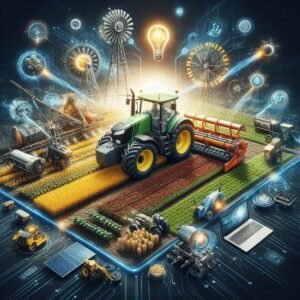Agricultural machinery has seen remarkable advancements in recent years, revolutionizing farming practices and boosting productivity. From autonomous tractors to drones, these innovations are helping farmers meet growing global food demands while reducing labor costs, conserving resources, and enhancing efficiency. Here’s a look at the top innovations in agricultural machinery that are transforming farming practices.
1. Autonomous Tractors
Autonomous tractors are one of the most groundbreaking innovations in modern agriculture. These driverless machines use GPS technology, artificial intelligence (AI), and sensors to perform various farming tasks with minimal human intervention. They can plow fields, plant seeds, and even harvest crops autonomously.
-
Key Benefits:
- Increased efficiency and precision in planting and harvesting
- Ability to work 24/7, leading to higher productivity
- Reduced labor costs and reliance on human workers
-
Example: Companies like John Deere and CNH Industrial have already introduced autonomous tractors that can be programmed and controlled remotely via a smartphone or computer.
2. Drones for Crop Monitoring and Spraying
Drones are rapidly becoming an essential tool for precision agriculture. Equipped with high-resolution cameras and sensors, agricultural drones provide real-time data on crop health, soil conditions, and water levels. They can also be used for spraying fertilizers and pesticides with pinpoint accuracy, reducing chemical waste and minimizing environmental impact.
-
Key Benefits:
- Real-time monitoring of large fields for better crop management
- Accurate spraying of fertilizers and pesticides, reducing resource use
- Early detection of pests, diseases, and water stress
-
Example: DJI’s Agras series is designed specifically for agricultural use, offering precision spraying and aerial surveying capabilities.
3. Smart Irrigation Systems
Water is a critical resource in farming, and smart irrigation systems have revolutionized how water is managed. These systems use sensors, weather data, and software to optimize water usage, ensuring crops receive the right amount at the right time. Smart irrigation helps prevent overwatering and reduces water waste, especially in areas prone to drought.
-
Key Benefits:
- Efficient water usage, leading to lower water bills
- Reduced risk of crop damage from overwatering or underwatering
- Integration with soil and weather data for precise irrigation scheduling
-
Example: Systems like Netafim’s drip irrigation technology use sensors to monitor soil moisture and deliver water directly to plant roots, maximizing efficiency and minimizing waste.
4. Robotic Harvesting Machines
Harvesting labor can be time-consuming and expensive, especially during peak seasons. Robotic harvesting machines, equipped with advanced sensors and AI, are transforming this process by automating the picking and sorting of fruits and vegetables. These robots can handle delicate crops with precision, reducing the risk of damage while increasing harvesting speed.
-
Key Benefits:
- Increased harvesting speed and efficiency
- Reduced reliance on seasonal labor, which can be costly and difficult to source
- Precision harvesting reduces crop damage and waste
-
Example: Robots like the FFRobotics fruit picker use robotic arms to carefully pick fruits like apples, strawberries, and tomatoes, minimizing bruising and maximizing efficiency.
5. Precision Planting Equipment
Precision planting technology ensures that seeds are planted at the optimal depth and spacing, which is critical for maximizing crop yields. Modern planters use GPS, AI, and variable rate technology (VRT) to adjust the planting process based on soil conditions and crop type. This leads to better seed placement and more efficient use of resources.
-
Key Benefits:
- Optimal seed placement for higher yields
- Reduced seed waste and lower input costs
- Enhanced control over plant density and crop spacing
-
Example: John Deere’s ExactEmerge planters allow farmers to plant seeds at high speeds without compromising on accuracy, resulting in more uniform crop emergence.
6. Artificial Intelligence and Machine Learning
AI and machine learning (ML) are increasingly being integrated into agricultural machinery, helping farmers make data-driven decisions. By analyzing data from sensors, drones, and weather stations, AI systems can predict crop yields, recommend the best times for planting or harvesting, and detect potential issues like pest infestations or nutrient deficiencies.
-
Key Benefits:
- Improved decision-making based on real-time data analysis
- Enhanced crop management and yield predictions
- Early detection of crop diseases and pests for timely intervention
-
Example: IBM’s Watson Decision Platform for Agriculture uses AI and IoT (Internet of Things) to analyze weather, soil, and crop data, providing actionable insights to farmers.
7. Automated Weed Control Machines
Weed management is essential for maintaining crop health, but traditional herbicide spraying can be wasteful and harmful to the environment. Automated weed control machines use AI and machine vision to identify and target weeds with precision, allowing for more effective weed control while reducing the use of chemicals.
-
Key Benefits:
- Precise targeting of weeds reduces herbicide use
- Environmentally friendly alternative to blanket spraying
- Reduced labor costs associated with manual weeding
-
Example: The Blue River Technology‘s See & Spray system uses AI to identify weeds and apply herbicide only where needed, drastically cutting down chemical use.
8. Soil Sensors and Soil Monitoring Systems
Soil health is vital for crop success, and advanced soil sensors provide real-time data on soil moisture, temperature, and nutrient levels. These systems help farmers make informed decisions about irrigation, fertilization, and planting, leading to better crop yields and soil sustainability.
-
Key Benefits:
- Improved soil health management and nutrient optimization
- Reduced water and fertilizer use based on real-time data
- Enhanced crop performance and yield
-
Example: Systems like Teralytic use soil probes to monitor various soil parameters and provide actionable data to optimize irrigation and fertilization.
9. GPS and Satellite-Based Precision Farming
GPS technology has revolutionized precision farming, allowing farmers to map their fields and track machinery with pinpoint accuracy. Satellite imagery combined with GPS enables farmers to monitor crop conditions from above, identify problem areas, and apply inputs like water, fertilizer, or pesticides only where they are needed.
-
Key Benefits:
- Enhanced precision in planting, spraying, and harvesting
- Reduction in waste of seeds, water, and chemicals
- Increased efficiency and productivity
-
Example: Trimble’s GPS-guided steering systems help farmers automate their tractors, ensuring straight rows, accurate seed placement, and minimized overlap during planting and fertilizing.
10. Electric and Hybrid Tractors
As sustainability becomes a priority in agriculture, the development of electric and hybrid tractors is gaining momentum. These tractors reduce fuel consumption, lower greenhouse gas emissions, and offer quieter, more efficient operation compared to traditional diesel-powered models.
-
Key Benefits:
- Reduced carbon footprint and fuel costs
- Quieter operation, which is beneficial for farmers and nearby communities
- Improved energy efficiency and lower long-term operational costs
-
Example: Monarch Tractor has developed an electric tractor that offers both autonomous and traditional driving modes, reducing energy consumption and offering a sustainable alternative to diesel-powered tractors.
Conclusion
The innovations in agricultural machinery are transforming the way farming is done, making it more efficient, sustainable, and profitable. From autonomous tractors and drones to AI-driven analytics and precision planting, these technologies are not only improving productivity but also helping farmers manage resources better and reduce environmental impact. As these innovations continue to evolve, the future of farming will be marked by greater automation, precision, and sustainability.






YcYZS QRpgi sRpRX xfmDweu